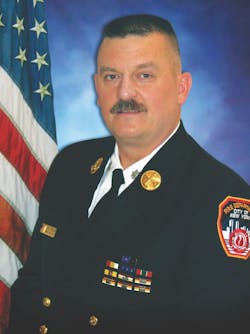The Fire Scene: The Control Firefighter
Let’s say that you work in an engine company in a department that has decent staffing. When you report for duty, what tactical position do you hope for? The answer for 99 percent of firefighters is the nozzle position, the most demanding and exciting position on an attack hoseline at a structure or building fire. Depending on the manner that hoselines are packed and pulled, an engine might have a control firefighter position. What must that member know to perform well?
How many lengths?
As an engine officer, I knew that most firefighters didn’t look forward to being assigned the control position. I also knew that the position has a dramatic effect on the effectiveness of the attack hoseline.
The basic job for the control firefighter is to make sure that the proper number of non-preconnected lengths of hose are stretched. Of course, preconnected line has a finite number of lengths that must be pulled, so, here, I’m talking about a dead load or a simple bed full of hose that isn’t preconnected, say 10 lengths of 2½-inch hose that’s reduced to six lengths of 1¾-inch hose, with a nozzle attached on top. When this hose is pulled, someone must decide how many of the 16 lengths must be utilized for the specific stretch.
How do control firefighters get this accomplished, and what skills and abilities do they need to be effective? Most engine officers assign a senior firefighter to the control position, because many items must be considered when the decision regarding how much hose might be required is made.
Yes, sufficient hose must be stretched to reach the fire area, but, at the same time, the control firefighter must ensure that too many lengths aren’t pulled. Pulling too much hose increases the chances of kinks (which can reduce water flow) and of loops of hose in rooms and hallways (which can obstruct firefighters who operate in those areas).
How does a control firefighter figure out how many lengths are required? Familiarity with the types and styles of structures and buildings that are in a unit’s response area provides the control firefighter with the route that the hoseline will take and how many lengths that will be required. Without this familiarity, it’s difficult, if not impossible, to estimate the number of lengths. For example, is there a “well” in the stairway? If there is, you can reach the fifth floor with a single, 50-foot length of hose rather than five lengths of hose.
Pulling the hose
Another important task for the control firefighter is the actual pulling and breaking of the hoseline from the hosebed during the stretch.
After the nozzle and lead length are pulled from the bed, the control firefighter must keep close control of the number of lengths that are pulled from the apparatus. If this person took a look at the fire building and knows the location of an upper floor fire and the distance that it is from the stairway, the control firefighter will have a specific number of lengths in mind and either will wave the engine to proceed to the hydrant or break the line after the correct number of lengths are removed. The chauffeur then will connect the coupling to the discharge and be ready to charge the line.
The control firefighter then is called upon to chase kinks up the entire length of the hoseline after it was charged to ensure that the flow of water at the nozzle isn’t reduced.
Embrace the role
Control firefighter might not be the most sought-after, most exciting assignment, but it certainly is one of the most vital for any attack hoseline at a structure or building fire.
About the Author
John J. Salka Jr.
Battalion Chief
JOHN J. SALKA JR., who is a Firehouse contributing editor, retired as a battalion chief with FDNY, serving as commander of the 18th battalion in the Bronx. Salka has instructed at several FDNY training programs, including the department’s Probationary Firefighters School, Captains Management Program and Battalion Chiefs Command Course. He conducts training programs at national and local conferences and has been recognized for his firefighter survival course, “Get Out Alive.” Salka co-authored the FDNY Engine Company Operations manual and wrote the book "First In, Last Out–Leadership Lessons From the New York Fire Department." He also operates Fire Command Training, which is a New York-based fire service training and consulting firm.

